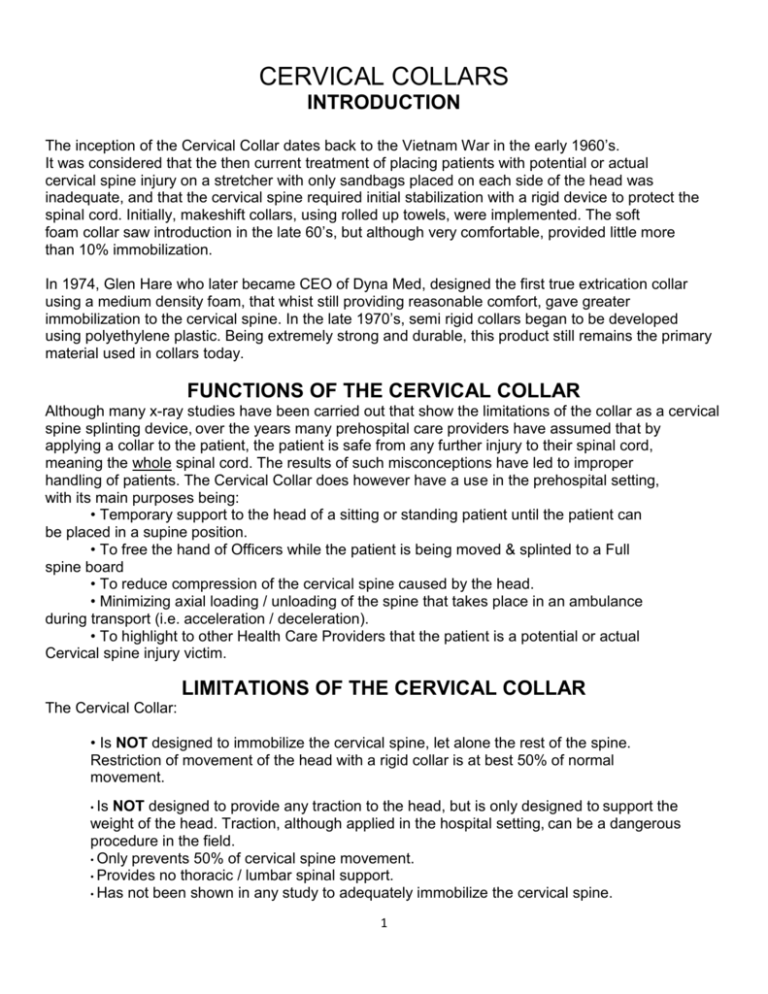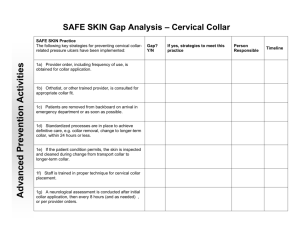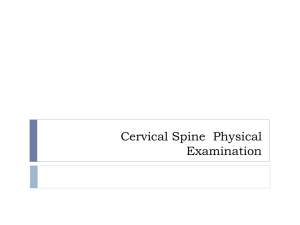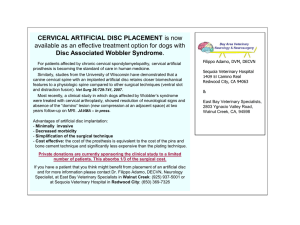CERVICAL COLLARS
advertisement

CERVICAL COLLARS INTRODUCTION The inception of the Cervical Collar dates back to the Vietnam War in the early 1960’s. It was considered that the then current treatment of placing patients with potential or actual cervical spine injury on a stretcher with only sandbags placed on each side of the head was inadequate, and that the cervical spine required initial stabilization with a rigid device to protect the spinal cord. Initially, makeshift collars, using rolled up towels, were implemented. The soft foam collar saw introduction in the late 60’s, but although very comfortable, provided little more than 10% immobilization. In 1974, Glen Hare who later became CEO of Dyna Med, designed the first true extrication collar using a medium density foam, that whist still providing reasonable comfort, gave greater immobilization to the cervical spine. In the late 1970’s, semi rigid collars began to be developed using polyethylene plastic. Being extremely strong and durable, this product still remains the primary material used in collars today. FUNCTIONS OF THE CERVICAL COLLAR Although many x-ray studies have been carried out that show the limitations of the collar as a cervical spine splinting device, over the years many prehospital care providers have assumed that by applying a collar to the patient, the patient is safe from any further injury to their spinal cord, meaning the whole spinal cord. The results of such misconceptions have led to improper handling of patients. The Cervical Collar does however have a use in the prehospital setting, with its main purposes being: • Temporary support to the head of a sitting or standing patient until the patient can be placed in a supine position. • To free the hand of Officers while the patient is being moved & splinted to a Full spine board • To reduce compression of the cervical spine caused by the head. • Minimizing axial loading / unloading of the spine that takes place in an ambulance during transport (i.e. acceleration / deceleration). • To highlight to other Health Care Providers that the patient is a potential or actual Cervical spine injury victim. LIMITATIONS OF THE CERVICAL COLLAR The Cervical Collar: • Is NOT designed to immobilize the cervical spine, let alone the rest of the spine. Restriction of movement of the head with a rigid collar is at best 50% of normal movement. • Is NOT designed to provide any traction to the head, but is only designed to support the weight of the head. Traction, although applied in the hospital setting, can be a dangerous procedure in the field. • Only prevents 50% of cervical spine movement. • Provides no thoracic / lumbar spinal support. • Has not been shown in any study to adequately immobilize the cervical spine. 1 Therefore following application of a Cervical Collar, Manual In-Line Stabilization of the head must be maintained until Full Spine Board Immobilization is achieved. DANGERS OF THE CERVICAL COLLAR A number of dangers may be associated with application of a Cervical Collar: • If the jaw support of the collar clamps the teeth together, airway compromise may result if the patient vomits. • Cervical Collars that place pressure on the neck (either via collar design or too small a Cervical Collar being applied), may cause an increase in intracranial pressure. CERVICAL COLLAR STABILITY The Cervical Collar gains it’s stability from below by: • Lateral contact with both of the clavicles. • Anterior contact with the sternum. • Posterior contact with the cervical spine at C7. The Cervical Collar gains it’s stability from above by: • Anterior contact of the jaw support with the jaw line, or • Preferably by anterior contact of the jaw support by the angle of the mandible. • Posterior contact with the occipital. 2 APPLYING THE CERVICAL COLLAR Step 1 • Rescuer 1 performs Manual In-Line Stabilization re-aligning the cervical spine if not contra-indicated. • If the cervical spine cannot be re-aligned, the rigid style Cervical Collar cannot be applied. • When applying Manual In-Line Stabilization, just enough traction should be applied to take the weight of the patient’s head off the cervical spine only. Further traction can be considered extremely dangerous in the prehospital setting. Step 2 • After the patient has been examined, Rescuer 2 selects the appropriate size Cervical Collar as per the manufacturers guidelines. • If possible, remove clothing around the patient’s neck and ensure the collar is in contact with the bare skin for improved stability. 3 • Slide the Cervical Collar along the patient’s chest and into position. • If using a rigid style Cervical Collar with a jaw support, ensure that the front of the jaw support and patient’s anterior aspect of the jaw are level. If the Cervical Collar jaw support protrudes past the patient’s jaw, the Cervical Collar is too small. Another Cervical Collar will then need to be selected even if the manufacturer’s guidelines for measuring were correctly followed. Correct Size Too Small Too Large Step 3 • Once the correct size Cervical Collar has been chosen, remove the Cervical Collar away from the patient’s sternum. • Reapply the Cervical Collar by sliding the Cervical Collar in sideways from the right side. Step 4 • Once the Cervical Collar has been slid in behind the patient, Rescuer 2 locates & holds the Collar’s Velcro tab in their right hand. 4 • Rescuer 2 now slides the Cervical Collar’s right shoulder arch into position on the patient’s right shoulder. Step 5 • Slide the Cervical Collar’s jaw support into position and ensure the Cervical Collar is correctly centered anteriorly on the patient’s jaw and sternum. • Rescuer 2 now secures the Velcro closure. • Rescuer 1 continues to maintain Manual In-Line Stabilization until the patient is immobilized onto a Cervical Extrication Device or onto a Full Spine Board as a Cervical Collar has been shown to provide inadequate cervical spine immobilization. 5









